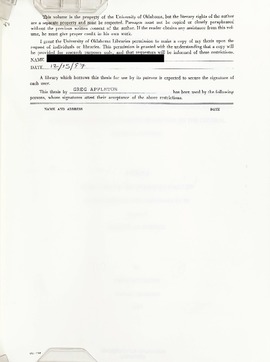| dc.contributor.advisor | Forgotson, James M. Jr | |
| dc.contributor.author | Appleton, Greg | |
| dc.date.accessioned | 2017-11-22T20:31:25Z | |
| dc.date.available | 2017-11-22T20:31:25Z | |
| dc.date.issued | 1997 | |
| dc.identifier.citation | Appleton, G. (1997). Exploration of the Wichita/Albany Reservoir, Sandhills Field, Crane County, Texas : Searching for Hydrocarbons in a Previously Under-exploited Reservoir on the Central Basin Platform. | |
| dc.identifier.uri | https://hdl.handle.net/11244/52423 | |
| dc.description.abstract | The Permian age Wichita/Albany formation was deposited on the Central Basin
Platform in the Permian Basin of west Texas during the upper Wolfcampian and lower
Leonardian periods. The Sandhills structure, an uplifted block on the Central Basin
Platform contains the 456th largest oil field in the world. The Sandhills field is 52,000 acres in size and the Permian section rests directly on the Ordovician due to the Base of Permian Unconformity. | |
| dc.description.abstract | This study focuses on the Wichita/Albany formation in the Sandhills Oil Field. The Wichita/Albany occurs as a 1000 ft. thick formation consisting of uranium rich, peritidal dolomite, with porosity relating to the degree of dolomitization. Production of hydrocarbons from this zone has been limited to three wells producing 100% hydrocarbons and 0% water. Only 16 wells have penetrated the complete Wichita/Albany formation. Production occurs from the stratigraphic units directly on top of and below the Wichita/Albany. These are the Permian Lower Clearfork, above, and the Ordovician Ellenburger formation, below. Porosity and water saturation values determined from well logs indicate much untapped potential for exploitation in the Wichita/Albany reservoir. Mapping porosity trends is difficult due to limited production and drillwells. Controls on porosity and exact depositional environment can not be confirmed because no core data available from the Wichita/Albany section. Based on available data, it seems that production is possible from the Wichita/Albany wherever porosity is present. This porosity occurs in thin, lenticular, pods that are discontinuous throughout the field. Structure does not seem to play a part in porosity distribution. The occurrences of this porosity may be related to structure during deposition and not present day structure. | |
| dc.format | xii, 72 leaves : ill., maps (some col.) ; 29 cm.. | |
| dc.language | en_US | |
| dc.subject | Oil reservoir engineering -- Texas -- Crane County | |
| dc.subject | Oil fields -- Texas -- Crane County | |
| dc.subject | Oil well logging -- Texas -- Crane County | |
| dc.subject | Geology and Geophysics, School of | |
| dc.subject | Texas--Crane County | |
| dc.subject | Oil fields--Texas--Sandhills Field | |
| dc.subject | Texas--Central Basin Platform | |
| dc.subject | Texas--Permian Basin | |
| dc.subject | Wichita-Albany Formation | |
| dc.subject | Permian | |
| dc.subject | Reservoir study | |
| dc.subject | Structure | |
| dc.subject | Dolomite | |
| dc.title | Exploration of the Wichita/Albany reservoir, Sandhills field, Crane County, Texas : searching for hydrocarbons in a previously under-exploited reservoir on the Central Basin Platform | |
| dc.title.alternative | Exploration of the Wichita/Albany reservoir, Sandhills field, Crane County, Texas : searching for hydrocarbons in a previously under-exploited reservoir | |
| dc.type | Thesis | |
| dc.contributor.committeeMember | Downey, Marlan W. | |
| dc.contributor.committeeMember | Castagna, John P. | |
| dc.date.manuscript | 1997 | |
| dc.thesis.degree | Master of Science | |
| dc.note | Accompanied by 3 folded maps in pocket. | |
| ou.group | College of Geosciences::School of Geology and Geophysics | |

